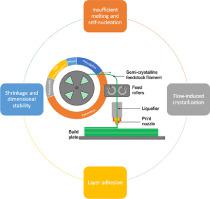Progress in Polymer Science ( IF 27.1 ) Pub Date : 2021-05-02 , DOI: 10.1016/j.progpolymsci.2021.101411 Dries Vaes , Peter Van Puyvelde

|
Additive Manufacturing (AM), and more specifically Fused Filament Fabrication (FFF), allow the production of highly customized parts, provide enormous freedom-of-design and can lead to material savings due to the layer-by-layer material deposition that is inherent to this family of production processes. FFF utilizes both amorphous and semi-crystalline thermoplastic filaments as feedstock materials, offering a wider range of materials compared to some other polymer-based additive manufacturing techniques. However, the current trend where FFF, and AM in general, are changing from a technique for rapid prototyping to the production of fully functional parts designed for high-end applications creates the inevitable need to incorporate more engineering and high-performance thermoplastics, which are most often semi-crystalline polymers, into the material palette. Crystallization provides semi-crystalline polymers with some distinct features that set them apart from their amorphous counterparts, yet it also can present difficulties regarding their processing. Understanding of the behavior of semicrystalline polymers during FFF processing is thus a prerequisite to exploit their full potential. This review provides a broad overview of FFF processing of semicrystalline polymers. Particular focus lies on the impact of processing conditions and feedstock modifications, such as the incorporation of fillers or the formation of blends, on crystallinity as well as the microstructure of printed parts, the impact of microstructure on the mechanical performance, and general part quality. Furthermore, attention is given to some specific phenomena that can occur during printing of semi-crystalline feedstock filaments which have shown to strongly impact the printing process. Examples are self-nucleation in the case of insufficient heat transfer and melting, flow-induced crystallization due to high shear deformations upon extrusion, and the negative impact of crystallization on chain mobility which is relevant for the development of interlayer strength and on dimensional accuracy due to excessive shrinkage. Finally, this review is concluded with a critical outlook on perspectives for future research to address the current challenges that are still faced when employing semi-crystalline polymers as FFF feedstock.
中文翻译:

半结晶原料,用于聚合物的基于长丝的3D打印
增材制造(AM),尤其是熔融长丝制造(FFF),可以生产高度定制的零件,提供极大的设计自由度,并且由于固有的逐层材料沉积,可以节省材料到这一系列的生产过程。FFF利用无定形和半结晶热塑性长丝作为原料,与其他一些基于聚合物的增材制造技术相比,FFF提供了更多的材料。但是,目前的趋势是FFF和AM总体上已经从快速成型技术转变为为高端应用设计的功能齐全的零件的生产,这不可避免地需要结合更多的工程塑料和高性能热塑性塑料。最常见的是半结晶聚合物 进入材料调色板。结晶为半结晶聚合物提供了一些独特的功能,使它们与无定形的同类产品区分开,但也可能给加工带来困难。因此,了解半结晶聚合物在FFF加工过程中的行为是开发其全部潜力的先决条件。这篇综述提供了半结晶聚合物FFF加工的广泛概述。特别关注的是加工条件和原料改性的影响,例如填料的掺入或共混物的形成,对结晶度以及印刷零件的微观结构的影响,微观结构对机械性能的影响,以及一般零件的质量。此外,注意在印刷半结晶原料长丝的过程中可能发生的某些特定现象,这些现象已显示出对印刷过程的强烈影响。例如,在传热和熔融不充分的情况下发生自成核,由于挤压时高剪切变形导致的流动诱导结晶以及结晶对链迁移率的负面影响,这与中间层强度的发展和尺寸精度有关。过度收缩。最后,本篇综述以对未来研究的观点的批判性展望结束,以解决使用半结晶聚合物作为FFF原料时仍然面临的当前挑战。例如,在传热和熔融不充分的情况下发生自成核,由于挤压时高剪切变形导致的流动诱导结晶以及结晶对链迁移率的负面影响,这与中间层强度的发展和尺寸精度有关。过度收缩。最后,本篇综述以对未来研究的观点的批判性展望结束,以解决使用半结晶聚合物作为FFF原料时仍然面临的当前挑战。例如,在传热和熔融不充分的情况下发生自成核,由于挤压时高剪切变形导致的流动诱导结晶以及结晶对链迁移率的负面影响,这与中间层强度的发展和尺寸精度有关。过度收缩。最后,本篇综述以对未来研究的观点的批判性展望结束,以解决使用半结晶聚合物作为FFF原料时仍然面临的当前挑战。

























 京公网安备 11010802027423号
京公网安备 11010802027423号